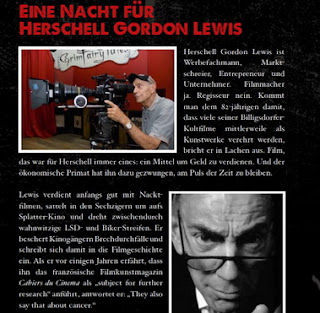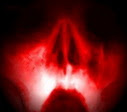Directed by Edgar Pêra;
Produced by Ana Costa;
Screenplay by Luísa Costa Gomes, mr. Pêra, based on the novella by Branquinho da Fonseca, O Barão;
Music by Vozes da Rádio;
Director of photography: Luís Branquinho;
Art director: Fernando Areal;
Starring Nuno Melo, Marcos Barbosa, Leonor Keil.
GHOUL RATING:
***(*)
4-
The Baron is a Portuguese film shot in retro-modern-scope, in glorious high contrast Black and White, boasting to be "a 2-D film by Edgar Pêra". One could say that it is modern precisely in its anti-modernity. It is almost impossible to describe this film without relying on comparisons: The Baron looks and feels like a weird re-enactment of a 1930s horror film through the arty lense of a very talented modern director – something along the lines of Almereyda's Nadja, Merhige's Begotten and Maddin's Dracula: Pages from a Virgin's Diary. There are also droning soundscapes and grotesquely nightmarish non-sequitur situations in which humor and horror are disquietingly close reminiscent of David Lynch.
The key overall effect is instability. Nothing in the world directed by Edgar Pêra is permanent: the images dissolve or overlap, the lights and darkness come and go, a huge room is suddenly shrunk to a black solitary cell... Nothing is stable. The same goes for his narrative, with only the vaguest respect to linearity and conventional logic. The events are governed by dream logic, and The Baron may easily be one of the most oneiric narrative films in recent times – or perhaps since the days of Jean Cocteau.
For those yearning for plot, here's the essence: it all starts like Kafka's The Castle, with a frail-looking school inspector visiting a remote ("off the maps") village whose name he's forgotten. Unlike K. he is almost forced into the towering prison-like structure and brought to the powerful Baron who governs the region through fear. Just in case there's any doubt, he keeps repeating: "I'm the one in charge!" What follows after the inspector's arrival to the Castle is a series of increasingly nightmarish scenarios, although the terrors are rarely specific. As in the films produced by Val Lewton in the 1940s (humorously alluded to in the prologue), few are the scenes of direct horror, yet the sense of foreboding and doom hangs over all.
The center of it, of course, is the Baron himself: as played by Nuno Melo, he is one of the most charismatic and memorable "gothic" villains ever since Klaus Kinski had his larger-than-life role in Nosferatu (1979). It is a performance which cannot be praised enough: the entire film hangs on Mr Melo's strong sholders and his commanding, scene-stealing presence haunts the screen even when he is not visible. His Baron is a force of nature and a joy to watch (from a safe distance, that is)! The other players are very fine indeed, but inevitably overshadowed by the iconic presence of Nuno Melo.
Of course, Edgar Pêra as the veteran avant-garde director, Luís Branquinho as his trusted director of photography and Fernando Areal as art director (with his sparse, heavily stylized sets) are equally prominent stars of The Baron. Their job in creating this world of floating shadows and vague nightmares of oppression (political and existential, almost metaphysical) is nothing short of amazing. This is a daring, original and highly memorable work of a true visionary and demands the audience ready and willing to be surprised by something unconventional and new.
This, however, doesn't mean that the film is all about doom and gloom and slowburning terrors: it is also very funny in its own idiosyncratic and eccentric ways. Its playful absurdities are channeling Kafka's insight of the proximity between horror and humor, and its vision of the world is at the same time very dark, and somewhat tongue-in-cheek, too.
This review is based on the film's screening at Vienna's Slashfest, where Mr Pera was a delightful guest. His next film will be a very original adaptation of H. P. Lovecraft's The Horror at Red Hook seen as a parable of racism. Let's pray to the Elder Gods that this happens soon!
Here is the trailer:
This review originally published at Beyond Hollywood.






















































